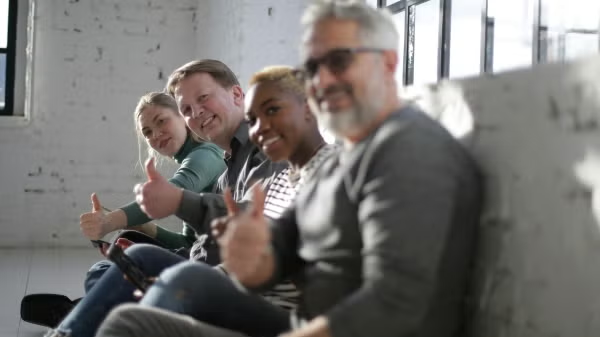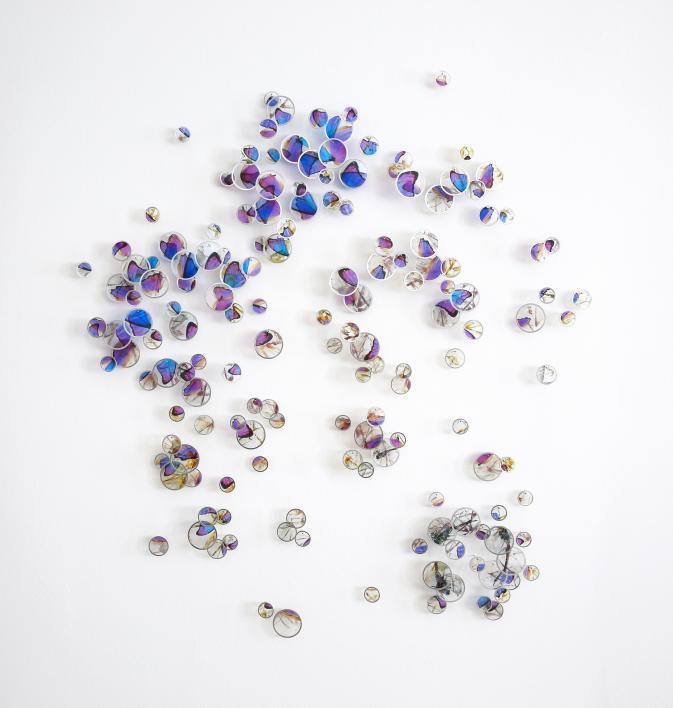Biomimicry is an approach to problem-solving that looks at how nature has already done it. In this philosophy, people create a sustainable lifestyle by observing how animals and plants have overcome obstacles in adapting to the environment.
A new exhibit at the Tempe Center for the Arts, “Biomimicry: Nature Inspired Design,” explores the connections between this philosophy and art. And because Arizona State University is a leader in the field of biomimicry, several faculty members and alumni are involved in the show, which also includes events to inspire community members.
The exhibit, which runs through Aug. 26 in the gallery, includes beautiful pieces that evoke the lovely but practical aspects of the natural world — butterfly wings, a snake’s spine, seeds that float through the air on fibers.
Biomimicry is a shift from “people-centered” design to “life-centered” design, according to Prasad BoradkarBoradkar, a professor of industrial design in the Herberger Institute for Design and the Arts, also is director of InnovationSpace at ASU., co-director of the Biomimicry Center at ASU.
“Nature has been evolving for billions of years, and organisms have learned to adapt to their environment and cohabit with other organisms in their ecosystems,” said Boradkar, who is currently working on a project with Google in Mountainview, California.
“What humans have done from a design perspective and manufacturing and business perspective is we have created a world in which we don’t think of longevity or environmental or social impact.”
Waste, for example.
“Waste is not a problem in nature. Leaves from a tree degrade quickly and become useful for other organisms,” he said. “How do we handle waste? We create landfills. We dump it in a location we can’t see it.”
Students in the Biomimicry Center work across disciplines to find solutions, Boradkar said.
“The impact of design and manufacturing of new products doesn’t affect only humans. It affects all species on the planet. So why don’t we learn from all species on the planet?” he said.
Many everyday products and technologies have been inspired by biomimicry, such as hook-and-loop closures, also known as VelcroThe Velcro Co. is one of the sponsors of the exhibit, along with the following ASU units: the Biomimicry Center, the LeRoy Eyring Center for Solid State Science, the Julie Ann Wrigley Global Institute of Sustainability and the Natural History Collection in the School of Life Sciences.. That was created in the 1960s when a scientist’s dog kept getting covered in burrs. Frustrated, the scientist looked at the seeds’ “grippers” under a microscope and was inspired to invent the fastening product.
The shape of moth wings have led to solar-power designs, and the echolocation abilities of sea mammals created the basis of radar. More recently, the slick swimsuits worn by the U.S. swim team in the 2008 Olympics were based on the composition of shark skin. They were later banned for giving an unfair advantage.
And an ASU-designed robot used a sea turtle's flippers as inspiration for a way to navigate different types of terrain.
The principles of nature have shaped not only what the Tempe exhibit’s artworks look like, but how they were created as well, according to Michelle Dock, gallery director.
“What we found with a lot of artists is that they’re inherently doing those sorts of things with this discipline that’s kind of new and also kind of old,” she said.
For example, artist Emily Longbrake incorporated the structure of a snake’s spine into her wood-and-string sculpture on display in the exhibit. When faced with the challenge of how to efficiently ship her artworks, she studied the ball-and-socket anatomy of a slithering snake, then incorporated ceramic balls into her design, which allows it to be flattened.
Damon McIntyre, a wood sculptor and instructor in the School of Art at ASU, has several pieces in the exhibit that he created out of some old pecan trees that were cut down on campus. The concept of biomimicry comes in with a table that has an asymmetric base.
“He’s emulating the root system of a tree to strengthen the legs,” Dock said.
Alexandra Bowers uses a wood-burning tool to etch the image of a feather onto a wooden box. Bowers, who earned a Bachelor of Fine Arts degree at ASU, is one of three artists in residence at the "Biomimicry" exhibit at the Tempe Center for the Arts. Photo by Charlie Leight/ASU Now
The program includes three artists in residence, photographer Nissa Kubly, sculptor Jose Benavides and wood-burning artist Alexandra Bowers, who are working with ASU faculty members in the sciences to broaden their understanding of how nature informs design. Benavides and Bowers both received degrees from ASU.
“This is an in-depth study for them to take their work in another direction,” Dock said of the collaboration.
The three are working in pop-up studios in the gallery through July 21.
Another part of the biomimicry exhibit is outreach. The center is holding several events for community members to experience the connection between art and nature. Several of the events will feature ASU faculty, including:
• Family Arts and Sciences workshops every Saturday from noon to 2 p.m. The July 15 session will feature faculty from the Julie Ann Wrigley Global Institute of Sustainability at ASU, and July 22 will be “Beyond the Collection Box” with ASU’s Natural History Collections.
• Satellite workshops at the Edna Vihel Center for the Arts in Tempe on June 24 and July 15 with artists and Kyra Galanis, who has a degree in biomimicry from ASU.
• Bee Hive Café for Teens from 4 to 7 p.m. June 16 and June 23 will feature free brainstorming sessions for art groups, science clubs and robotics teams, with free coffee. Boradkar will speak to the teens at 4:30 p.m. June 23.
• Dayna Baumeister, co-founder and co-director of the Biomimicry Institute at ASU, will give a free lecture at 7 p.m. Aug. 24.
Boradkar said he’s excited to discuss biomimicry with young people, and that outreach is an important part of the Biomimicry Center’s mission.
“We approach it by talking about the concept of ‘biophilia’ — ‘bio’ is life and ‘philia’ is affection,” he said.
“We all have an innate desire to be connected to nature.”
Click here for details and information on how to register for the satellite workshops.
Top photo: Artist Alexandra Bowers holds a dandelion seed, an inspiration for her work. Photo by Charlie Leight/ASU Now
More Science and technology
Statewide initiative to speed transfer of ASU lab research to marketplace
A new initiative will help speed the time it takes for groundbreaking biomedical research at Arizona’s three public universities to be transformed into devices, drugs and therapies that help people.…

ASU research seeks solutions to challenges faced by middle-aged adults
Adults in midlife comprise a large percentage of the country’s population — 24 percent of Arizonans are between 45 and 65 years old — and they also make up the majority of the American workforce…

ASU research helps prevent substance abuse, mental health problems and more
Smoking rates among teenagers today are much lower than they were a generation ago, decreasing from 36% in the late 1990s to 9% today. The rates of alcohol consumption among underage drinkers…





